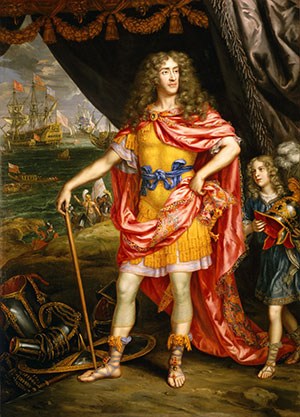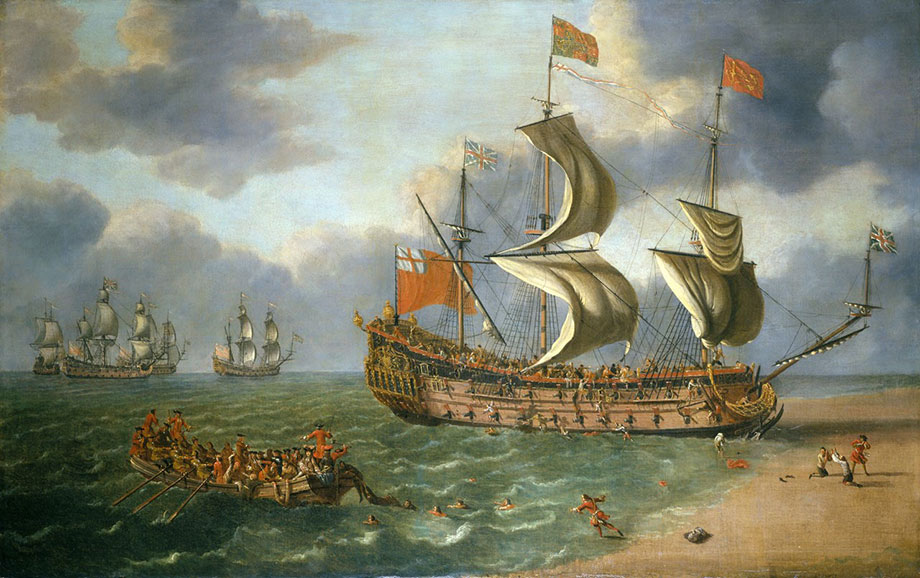On May 6, 1682 the Gloucester ran aground on a sandbank off the coast of Norfolk. Half-buried on the seabed, its exact whereabouts have been unknown for more than 300 years.

However, after a four-year search by brothers Julian and Lincoln Barnwell with several others, the historic ship was discovered. What makes this story all the more incredible is that the warship was carrying the future King of England, James Stuart.
The Gloucester represents an important ‘almost’ moment in British political history: a royal shipwreck causing the near-death of the Catholic heir to the Protestant throne at a time of great political and religious tension.
Lincoln Barnwell said he was partly inspired to search for the wreck after watching the lifting of the Mary Rose on television as a child.
“It was our fourth dive season looking for Gloucester,” he said. “We were starting to believe that we were not going to find her, we had dived so much and just found sand. On my descent to the seabed the first thing I spotted were large cannon laying on white sand, it was awe- inspiring and really beautiful.”
Julian added: “When we decided to search for the Gloucester we had no idea how significant she was in history. We had read that the Duke of York was on board but that was it. We were confident it was the Gloucester, but there are other wreck sites out there with cannons, so it still needed to be confirmed. There is still a huge amount of knowledge to be gained from the wreck, which will benefit Norfolk and the nation.



Together with their late father Michael, and two friends including James Little, a former Royal Navy submariner and diver, the Barnwell brothers found the wreck site in 2007, with the Gloucester split down the keel and remains of the hull submerged in sand. It is still to be determined how much of the hull is under the sand and what is intact. There are currently no plans to raise any part of the remains, the exact location of which is protected and cannot be made public.
The ship’s bell, manufactured in 1681, was recovered, and in 2012 it was used by the Receiver of Wreck and Ministry of Defence to decisively identify the vessel. Due to the time taken to confirm the identity of the ship and the need to protect an ‘at risk’ site, which lies in international waters, it is only now that its discovery has been made public. As well as the Receiver of Wreck and Ministry of Defence, the wreck has been declared to Historic England.

Artefacts rescued and conserved include clothes and shoes, navigational and other professional naval equipment, personal possessions and many wine bottles. Due to the age and prestige of the ship, the condition of the wreck, the finds already rescued and the accident’s political context, the discovery has been described by maritime history expert Prof Claire Jowitt, of the University of East Anglia, as the most important maritime discovery since the Mary Rose.

In 1682 the Gloucester was selected to carry James Stuart, Duke of York, to Edinburgh to collect his heavily pregnant wife and their households. The plan was to bring them back to King Charles II’s court in London in time, it was hoped, for the birth of a legitimate male heir.
The ship set sail from Portsmouth, with the Duke and his entourage joining it off Margate. At 5.30am on 6 May, the Gloucester ran aground some 45km off Great Yarmouth following a dispute about navigating the treacherous Norfolk sandbanks. The Duke, a former Lord High Admiral, had argued with the pilot for control over the ship’s course.
Within an hour the vessel sank. The Duke barely survived, having delayed abandoning ship until the last minute. Between 130 and 250 people (of approximately 330 passengers and crew in total on board) are estimated to have died. They included the Earl of Roxburghe, Lord Ibrackan, Sir John Hope and the Duke’s brother-in-law James Hyde, 2nd lieutenant on the Gloucester.

Diarist and naval administrator Samuel Pepys, who witnessed events from another ship in the fleet, wrote an account describing the harrowing experience for victims and survivors, with some picked up “half dead” from the water.
A major exhibition is now planned for spring 2023, the result of a partnership between the Barnwell brothers, Norfolk Museums Service and academic partner UEA. Running from February to July at Norwich Castle Museum & Art Gallery, the exhibition will display finds from the wreck – including the bell that confirmed the ship’s identity – and share ongoing historical, scientific and archaeological research.

Prof Jowittis, a co-curator of the exhibition, said: “It is an outstanding example of underwater cultural heritage of national and international importance. A tragedy of considerable proportions in terms of loss of life, both privileged and ordinary, the full story of the Gloucester’s last voyage and the impact of its aftermath needs re-telling, including its cultural and political importance, and legacy.”
www.gloucestershipwreck.co.uk

















